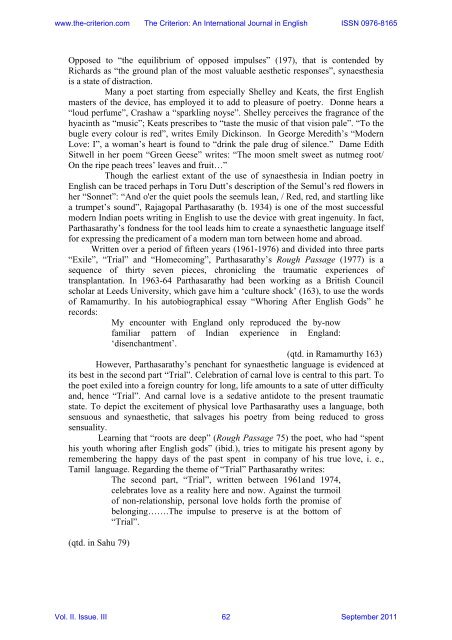Vol. II. Issue. III September 2011 - The Criterion: An International ...
Vol. II. Issue. III September 2011 - The Criterion: An International ...
Vol. II. Issue. III September 2011 - The Criterion: An International ...
You also want an ePaper? Increase the reach of your titles
YUMPU automatically turns print PDFs into web optimized ePapers that Google loves.
www.the-criterion.com <strong>The</strong> <strong>Criterion</strong>: <strong>An</strong> <strong>International</strong> Journal in English ISSN 0976-8165<br />
Opposed to “the equilibrium of opposed impulses” (197), that is contended by<br />
Richards as “the ground plan of the most valuable aesthetic responses”, synaesthesia<br />
is a state of distraction.<br />
Many a poet starting from especially Shelley and Keats, the first English<br />
masters of the device, has employed it to add to pleasure of poetry. Donne hears a<br />
“loud perfume”, Crashaw a “sparkling noyse”. Shelley perceives the fragrance of the<br />
hyacinth as “music”; Keats prescribes to “taste the music of that vision pale”. “To the<br />
bugle every colour is red”, writes Emily Dickinson. In George Meredith’s “Modern<br />
Love: I”, a woman’s heart is found to “drink the pale drug of silence.” Dame Edith<br />
Sitwell in her poem “Green Geese” writes: “<strong>The</strong> moon smelt sweet as nutmeg root/<br />
On the ripe peach trees’ leaves and fruit…”<br />
Though the earliest extant of the use of synaesthesia in Indian poetry in<br />
English can be traced perhaps in Toru Dutt’s description of the Semul’s red flowers in<br />
her “Sonnet”: “<strong>An</strong>d o'er the quiet pools the seemuls lean, / Red, red, and startling like<br />
a trumpet’s sound”, Rajagopal Parthasarathy (b. 1934) is one of the most successful<br />
modern Indian poets writing in English to use the device with great ingenuity. In fact,<br />
Parthasarathy’s fondness for the tool leads him to create a synaesthetic language itself<br />
for expressing the predicament of a modern man torn between home and abroad.<br />
Written over a period of fifteen years (1961-1976) and divided into three parts<br />
“Exile”, “Trial” and “Homecoming”, Parthasarathy’s Rough Passage (1977) is a<br />
sequence of thirty seven pieces, chronicling the traumatic experiences of<br />
transplantation. In 1963-64 Parthasarathy had been working as a British Council<br />
scholar at Leeds University, which gave him a ‘culture shock’ (163), to use the words<br />
of Ramamurthy. In his autobiographical essay “Whoring After English Gods” he<br />
records:<br />
My encounter with England only reproduced the by-now<br />
familiar pattern of Indian experience in England:<br />
‘disenchantment’.<br />
(qtd. in Ramamurthy 163)<br />
However, Parthasarathy’s penchant for synaesthetic language is evidenced at<br />
its best in the second part “Trial”. Celebration of carnal love is central to this part. To<br />
the poet exiled into a foreign country for long, life amounts to a sate of utter difficulty<br />
and, hence “Trial”. <strong>An</strong>d carnal love is a sedative antidote to the present traumatic<br />
state. To depict the excitement of physical love Parthasarathy uses a language, both<br />
sensuous and synaesthetic, that salvages his poetry from being reduced to gross<br />
sensuality.<br />
Learning that “roots are deep” (Rough Passage 75) the poet, who had “spent<br />
his youth whoring after English gods” (ibid.), tries to mitigate his present agony by<br />
remembering the happy days of the past spent in company of his true love, i. e.,<br />
Tamil language. Regarding the theme of “Trial” Parthasarathy writes:<br />
<strong>The</strong> second part, “Trial”, written between 1961and 1974,<br />
celebrates love as a reality here and now. Against the turmoil<br />
of non-relationship, personal love holds forth the promise of<br />
belonging…….<strong>The</strong> impulse to preserve is at the bottom of<br />
“Trial”.<br />
(qtd. in Sahu 79)<br />
<strong>Vol</strong>. <strong>II</strong>. <strong>Issue</strong>. <strong>II</strong>I 62 <strong>September</strong> <strong>2011</strong>
















